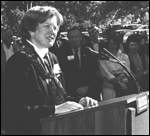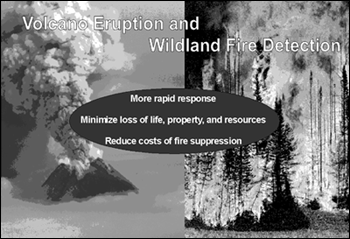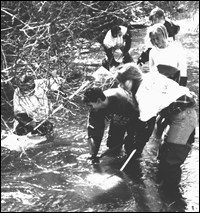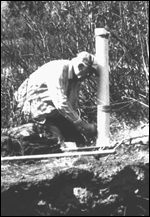
Patricia J. Beneke at the Biological Resources Division's first anniversary tree planting ceremony.

Patricia J. Beneke at the Biological Resources Division's first anniversary tree planting ceremony. |
USGS is facing a bright scientific future. In his book, The Wisdom of the Sands, Antoine de Saint- Exupery said, "As for the future, your task is not to foresee, but to enable it." With the one-year anniversary of the addition of the Biological Resources Division, USGS is focusing the ability to "enable" on the "new" USGS and where the bureau is headed in the years to come. The addition of the biological sciences to the existing strong set of physical science disciplines has added an important new dimension and set of capabilities to the USGS, and the timing of the addition is fortuitous. Over the last decade there has been considerable discussion within the scientific community about the need to examine natural resource issues from a multidisciplinary perspective. In nature, as the saying goes, "everything is connected to everything else," and so our science should reflect these interconnections.
The efforts to encourage multidisciplinary research have allowed us to present a strong case to the Department, the Office of Management and Budget, and Congress for support of continuing and new science programs. Focusing on the resources, hazards, environment, and information themes has provided an opportunity to present the USGS in terms of integrated science capabilities directed to challenges facing the Nation, as opposed to isolated research activities artificially divided by disciplines.
The USGS is well positioned to make major scientific contributions in each of these thematic areas. Land and water resources are increasingly constrained, and the use and conservation of these national assets will become an increasingly important issue in the future. Several decades of major research accomplishments related to earthquakes, volcanoes, floods, and other natural hazards place the USGS in an excellent position to make further contributions in reducing the loss of human life and property resulting from these events.
The capability to provide information about hazards on a real-time basis is transforming the way Government officials and the public prepare for and respond to natural disasters. The Bureau's extensive mapping, geographic information, and data storage and transfer expertise will allow USGS to play a leadership role in ensuring a solid scientific foundation for future natural resource decision making. The USGS will certainly continue to be called on to use its multidisciplinary expertise to address the many environmental challenges facing the Nation and the world. All of these activities benefit from appropriately balanced fundamental and applied research and other activities.

USGS and Federal partners integrate classified and civilian remotely sensed data to permit earlier and more accurate detection and response. |
One of the keys to success in the past has been the forging of partnerships between USGS and State and local governments, universities, other Federal agencies, nonprofit organizations, and industry. The viability of the new USGS will continue to depend on the effectiveness of these partnerships and the ability to work cooperatively while ensuring the quality, impartiality, and relevance of the USGS's scientific programs.
USGS will have just as important and essential a role in building and rebuilding the Nation in the 21st century as we did in the 19th and 20th centuries, but the role will be different and it will change with time. We have become the Nation's chief natural science agency for a reason and a purpose -- to provide the kind of science that will serve the citizen and help the Nation adapt to a rapidly changing world; to be the agency that can help this Nation find, protect, develop, and enjoy the natural resources that are essential for building and living in the next century; and to be an agency that can help significantly reduce the risk of natural hazards. The new USGS motto, "science for a changing world," appropriately reflects the importance of looking forward and being sensitive to the changing needs of society.
The scene of competing uses of our Nation's natural resources is set with increasing population, diminishing resources in an increasingly technological and materialistic world that is beset with degrading urban infrastructure, waste disposal, water and land use conflicts, increasing stresses on lands and coasts, and increasing costs of natural disasters in growing urban areas. Who better to help with solving these pressing problems, both now and in the future, than the U.S. Geological Survey? USGS provides the basic knowledge and underlying data that define what is happening within and on the surface of the Earth. USGS describes how and why Earth phenomena affect the lives of both humans and other living resources on a variety of scales. This vital knowledge clearly "enables" the national leaders in making significant societal decisions.
A significant number of chronic health issues are known to be tied to the environment and, specifically, to Earth phenomena themselves. USGS has worked around the edges of this area in the past in a limited, but nonetheless important, way. This past work focused on specific earth materials such as selenium, asbestos, uranium, and radon and their impacts on our environment and health. Today USGS is involved in important research on bacterial and viral transport, both in ground water and wildlife; on the transport of pesticides and their metabolites; and the absorption of a number of toxic substances on sediment particles in rivers and lakes. The exposure of humans to toxic chemicals through uptake and storage by plants and animals in our food chain represents another deep societal concern to which the USGS contributes useful and meaningful understanding.

Clean up of the riparian area by student volunteers. |

Stan Church (USGS-GD) collecting core through contaminated sediments, Animas River, Colo. |
The USGS ability to "enable," limited only by imagination, for the USGS already has in its ranks the wide array of scientific skills and talents required -- bio/geochemists, surface- and ground-water hydrologists, mineralogists, bacteriologists, animal disease specialists, botanists, experts in image interpretation and geographic information systems, earthquake seismologists, volcanologists, and landslide experts. All have something to contribute to the well-being of the Nation.
This is the challenge for USGS -- to foster the ability to "enable" a future that will continue to excel in natural earth science even in an environment of projected flat-lined appropriation and inflation-adjusted funds, at least for the next half-decade, and brightened by the prospects of the growing support with nearly 2,000 separate partners around the world and at every level in every State. This is a future that asks the USGS to play a key role in building and rebuilding the economy, the environment, the level of health and safety, and a fundamental understanding of our natural resources, natural processes, and natural hazards.
This is the "new" USGS, one of the Nation's recognized and highly valued sources of "science for a changing world."